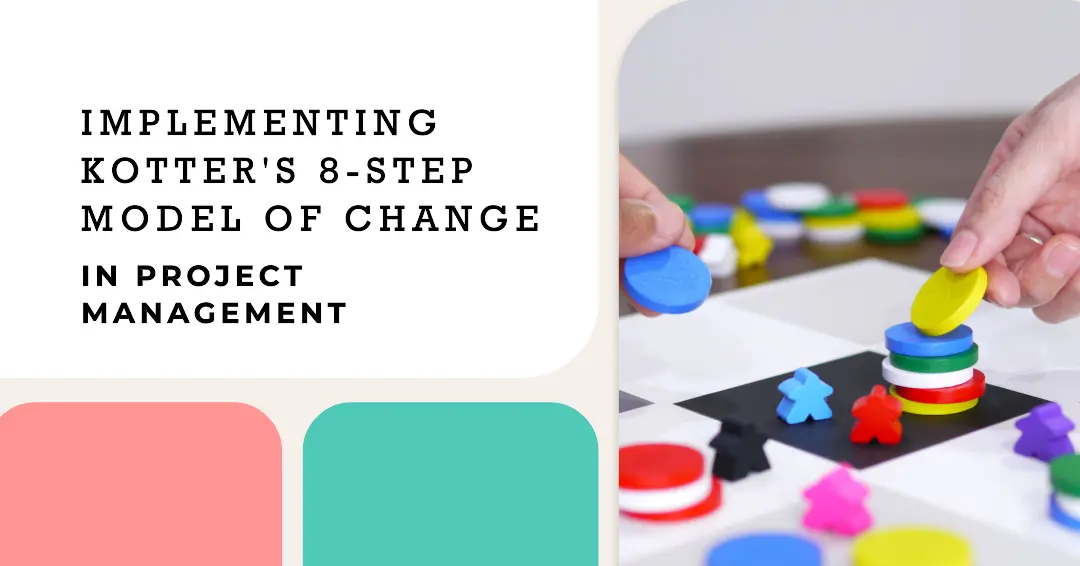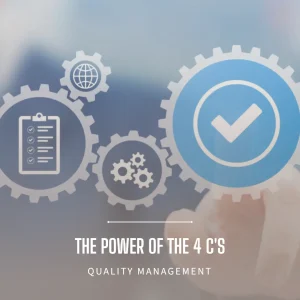I. Introduction
Change is inevitable, isn’t it? Whether we like it or not, change is the only constant in today’s fast-paced world. And when it comes to project management, the ability to manage change effectively can mean the difference between success and failure. But how do we navigate these turbulent waters and steer our projects towards a successful outcome? Enter Kotter’s 8-step model of change.
In this blog post, we’ll dive into the powerful and time-tested Kotter’s 8-step model of change and discuss how you can effectively apply it in your project management endeavors. We’ll share practical advice, tips, and tricks to help you and your team embrace change, overcome challenges, and achieve your project goals.
But before we get started, let’s take a moment to appreciate the importance of change management in project management. As a project manager, you’re responsible for delivering projects on time, within budget, and with the desired quality. However, projects are inherently dynamic, and changes are bound to occur. Being prepared for change and having the right tools and strategies to manage it can significantly increase your chances of success.
And that’s where Kotter’s 8-step model comes in. This model, developed by renowned change management expert Dr. John Kotter, has stood the test of time and is widely recognized as one of the most effective change management frameworks. Throughout this article, we’ll explore each step in detail, providing you with valuable insights on how to implement this model in your project management efforts. So, buckle up and get ready for an exciting journey towards mastering change management!
II. Kotter’s 8-Step Model of Change: An Overview
Before we jump into the nitty-gritty of implementing Kotter’s 8-step model in project management, let’s take a moment to familiarize ourselves with the model’s key concepts. Having a solid understanding of each step will provide a strong foundation for us to build on as we discuss practical applications in the following sections. So, let’s dive in!
A. Step 1: Establish a Sense of Urgency
The first and arguably most crucial step in the change process is to create a sense of urgency around the need for change. This involves recognizing and communicating the importance of the change to your team and stakeholders. When people understand the necessity and urgency of the change, they are more likely to support and engage in the process.
B. Step 2: Form a Powerful Coalition
Change cannot be accomplished alone. It’s essential to gather a strong team of individuals who share your vision and are committed to driving the change forward. This coalition can include key stakeholders, influencers, and team members who are passionate about the change and can help you spread the message across the organization.
C. Step 3: Create a Vision for Change
A clear and compelling vision is the guiding light that shows everyone where you’re heading. The vision should be inspiring, easy to understand, and aligned with the project’s goals and objectives. This step is all about creating a picture of the future state that everyone can rally around.
D. Step 4: Communicate the Vision
Once you’ve crafted your vision, it’s time to share it with the world! Use every communication channel at your disposal to ensure that the vision is well-understood and embraced by your team and stakeholders. Frequent, clear, and consistent communication is the key to success in this step.
E. Step 5: Empower Others to Act on the Vision
Now that your vision is out there, it’s time to empower your team to take action. This means providing the necessary resources, support, and authority to help your team members bring the vision to life. It also involves removing any barriers that might hinder progress.
F. Step 6: Generate Short-term Wins
Change can be a long and arduous journey. To keep your team motivated and engaged, it’s essential to celebrate small victories along the way. Break the project into manageable milestones and recognize the progress and achievements of your team. These short-term wins help to build momentum and reinforce the belief that the change is possible.
G. Step 7: Consolidate Gains and Produce More Change
Don’t rest on your laurels just yet! Use the momentum from your short-term wins to drive further improvements and changes. Analyze the impact of the change so far and identify areas where you can continue to make progress. This step is all about continuous improvement and not losing sight of the big picture.
H. Step 8: Anchor the Changes in Corporate Culture
Last but not least, make sure the changes you’ve introduced become an integral part of your project’s culture and processes. This will help ensure the long-term sustainability of the changes and prevent any backsliding. Celebrate the success of the change and reinforce the new behaviors and practices to make them stick.
And there you have it, a whirlwind tour of Kotter’s 8-step model of change. With this foundation in place, let’s move on to discuss how to put these steps into action in the context of project management.
III. Implementing Kotter’s Model in Project Management
Now that we have a solid understanding of Kotter’s 8-step model, let’s explore how we can apply these steps to manage change effectively within our projects. Get ready for some practical tips and advice that you can start implementing today!
A. Step 1: Establish a Sense of Urgency
Identify the need for change in the project: Keep an eye out for any signs that suggest your project needs to adapt to new circumstances or challenges. This could be changes in the market, customer needs, or even internal issues that require attention.
Communicate the importance of the change: Share your findings with your team and stakeholders, emphasizing the need for change and the consequences of not adapting. Be transparent, honest, and persuasive in your communication to create a sense of urgency.
Create a sense of urgency among team members: Encourage open discussions and invite feedback from your team. Make sure everyone understands the importance of acting quickly and decisively to address the change.
B. Step 2: Form a Powerful Coalition
Identify key stakeholders and influencers: Determine who within your organization has the influence, expertise, or passion necessary to help drive the change. This could include senior leaders, subject matter experts, or enthusiastic team members.
Secure their support and involvement: Reach out to these individuals and share your vision for the change. Encourage them to get involved and contribute their unique perspectives and skills to the project.
C. Step 3: Create a Vision for Change
Develop a clear vision for the project’s future state: Work with your coalition to create a shared vision that represents the desired outcome of the change. Make sure this vision is inspiring, achievable, and aligned with your project’s overall goals.
Align the vision with the project’s goals and objectives: Ensure that the vision supports the project’s objectives and helps drive progress toward its goals. This will ensure consistency and cohesion throughout the project.
D. Step 4: Communicate the Vision
Develop a communication plan: Outline the key messages, audiences, and channels through which you’ll communicate the vision. Regularly update your plan to ensure it remains relevant and effective.
Use multiple channels to share the vision with the team: Utilize a variety of communication methods to ensure that everyone on the team understands and embraces the vision. This could include team meetings, email updates, video messages, and even informal conversations.
E. Step 5: Empower Others to Act on the Vision
Provide necessary resources and support: Make sure your team has the tools, training, and support they need to execute the change effectively. This could include budget allocations, access to expertise, or the provision of training and development opportunities.
Remove barriers to change: Identify any obstacles that might prevent your team from acting on the vision and work to eliminate them. This could include outdated processes, lack of information, or resistance from certain team members.
F. Step 6: Generate Short-term Wins
Break the project into manageable milestones: Divide your project into smaller, achievable milestones that can be completed in the short term. This will help your team maintain focus and motivation throughout the change process.
Celebrate progress and successes: Acknowledge and celebrate the achievements of your team as they reach each milestone. This could include sending out congratulatory emails, hosting a team lunch, or recognizing individual contributions.
G. Step 7: Consolidate Gains and Produce More Change
Analyze the impact of the change: Regularly review the results of your change efforts and assess their impact on the project. Use this information to inform future change initiatives and improvements.
Identify areas for further improvement and change: Continuously look for opportunities to enhance your project and the change process itself. Seek feedback from your team and stakeholders to identify areas where additional change or improvement is needed.
H. Step 8: Anchor the Changes in Corporate Culture
Incorporate the changes into the project’s culture and processes: Ensure that the new behaviors, practices, and processes become an integral part of your project’s culture. This could involve updating documentation, integrating new methods into existing workflows, or redefining team roles and responsibilities.
Ensure long-term sustainability of the changes: Monitor the progress of the change over time and make any necessary adjustments to maintain its effectiveness. Continuously reinforce the new behaviors and practices to prevent backsliding and ensure the changes become firmly established within the project’s culture.
And there you have it! By applying Kotter’s 8-step model in your project management efforts, you’ll be well-equipped to navigate the complexities of change and lead your team towards success. Remember, change is a journey, and it requires persistence, patience, and commitment from everyone involved. So, go forth and embrace the power of change in your projects – the rewards are well worth the effort!
IV. Key Challenges and Solutions
As we’ve seen, Kotter’s 8-step model offers a robust framework for managing change in project management. However, implementing this model is not without its challenges. In this section, we’ll discuss some of the common obstacles you might face and offer solutions and best practices for overcoming them. Remember, every challenge is an opportunity for growth and learning!
A. Discuss potential challenges in implementing the 8-step model
Resistance to change: Change can be uncomfortable, and it’s natural for people to resist it, especially if they feel threatened or uncertain about the outcome. This resistance can manifest in various ways, from passive-aggressive behavior to outright refusal to participate in the change process.
Solution: Communicate openly and honestly about the reasons for the change and its benefits. Involve team members in the decision-making process and address their concerns and fears. Providing a supportive environment and empathizing with their feelings can go a long way in easing resistance.
Lack of leadership support: Without the backing of key leaders and decision-makers, your change efforts might struggle to gain traction. This lack of support can make it difficult to secure the necessary resources and buy-in for the change.
Solution: Engage leaders and stakeholders early in the change process, ensuring they understand the need for change and its potential impact on the project’s success. Demonstrate the value of the change with data, case studies, or pilot projects to win their support.
Insufficient communication: Poor communication can lead to confusion, misunderstandings, and a lack of alignment within your team. This can hinder your change efforts and make it difficult to maintain momentum.
Solution: Develop a comprehensive communication plan that outlines key messages, target audiences, and communication channels. Be consistent and transparent in your messaging, and encourage two-way communication to ensure everyone is on the same page.
Inadequate resources or support: Implementing change often requires additional resources, such as time, money, or expertise. If your team lacks the necessary support, they may struggle to execute the change effectively.
Solution: Assess the resources required for the change and advocate for their allocation. If necessary, consider creative solutions, such as reallocating resources from less critical projects, seeking external expertise, or utilizing in-house talent in new ways.
B. Offer solutions and best practices for overcoming these challenges
Foster a culture of continuous improvement: Encourage a mindset of ongoing learning and adaptation within your team. This can help create an environment where change is seen as a positive force rather than a threat.
Celebrate successes, both big and small: Recognizing and rewarding the efforts and achievements of your team can boost morale and motivate them to continue pushing forward with the change.
Be flexible and adaptable: While it’s essential to have a plan, recognize that change is often unpredictable. Be prepared to adjust your approach as needed, and don’t be afraid to pivot if circumstances demand it.
Maintain open lines of communication: Encourage honest feedback and maintain an open dialogue with your team and stakeholders throughout the change process. This can help you identify potential challenges early and address them proactively.
With these solutions and best practices in your toolkit, you’ll be well-equipped to tackle the challenges that may arise when implementing Kotter’s 8-step model in your project management efforts. Remember, the key to success is persistence, adaptability, and a willingness to learn from every experience. Happy changing!
V. Conclusion
As we reach the end of our journey exploring Kotter’s 8-step model of change in project management, I hope you feel inspired and empowered to embrace change in your own projects. Change can be daunting, but with the right approach, tools, and mindset, it can also be an incredible opportunity for growth and improvement.
We’ve covered a lot of ground in this blog post, from understanding the key concepts of Kotter’s model to discussing practical tips and strategies for implementing the model in your projects. We also tackled some of the common challenges you might face and offered solutions and best practices for overcoming them.
To recap, here are the key takeaways from our discussion:
- Establish a sense of urgency around the need for change.
- Form a powerful coalition to drive the change forward.
- Create a clear and compelling vision for the change.
- Communicate the vision consistently and effectively.
- Empower others to act on the vision.
- Generate short-term wins to build momentum.
- Consolidate gains and produce more change.
- Anchor the changes in your project’s culture and processes.
As you embark on your change journey, remember that success requires patience, persistence, and commitment. Embrace the challenges, learn from your experiences, and never lose sight of the vision that inspired you in the first place. By doing so, you’ll be well on your way to leading your projects through change and ultimately achieving your goals.
So, go forth, and let the power of Kotter’s 8-step model guide you on your path to successful project management. Together, we can embrace change and create a brighter future for ourselves and our teams. Good luck, and happy changing!
To find out how Artificial Intelligence is changing the Project Management landscape, you have enjoy reading this article https://www.shaunstoltz.com/did-artificial-intelligence-just-change-everything-about-project-management/
Find out more about Shaun Stoltz https://www.shaunstoltz.com/about/
This post was written by an AI and reviewed/edited by a human.



